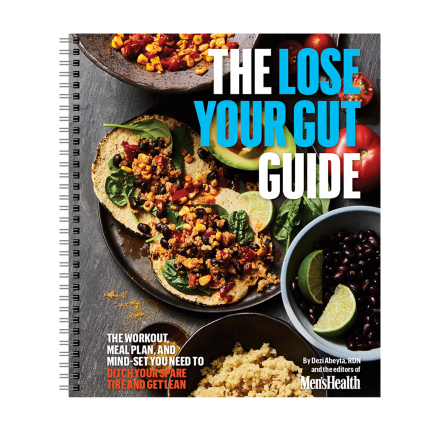THE DAD BOD craze has been fueled by one particularly distinctive factor: the beer belly.
The big, round belly can be a lovable trait (try to imagine Santa sans belly). It shows the world you like to have a little fun now and then. And while six pack abs aren’t for everybody, there may be a few reasons to pay a little closer attention to the state of your belly, especially if it’s hard to the touch. It can affect our health more than we think.
The hardness comes from a buildup of visceral fat—the kind of fat that builds up on your internal organs. That can cause a handful of unwanted health problems.
More From Men’s Health

“Having a hard belly is like having a ticking time bomb in your body,” says Jean-Pierre Despres, Ph.D., a professor of human nutrition at Laval University in Quebec City. “It increases your chances of heart disease and diabetes, and it’s worse than smoking or having high cholesterol.”
If you’re feeling stuck with a beer belly, don’t fret. Below, the ins and outs of what having a beer belly means for your health, and how to get rid of it.
Why Do Beer Bellies Develop?
A beer belly can develop for a number of reasons, like…
You have a buildup of hard fat
The first cause brings us to the root of your hard stomach: a high accumulation of visceral fat. Located in the spaces between organs in your abdominal cavity, visceral fat is packed in tightly, so there’s no jiggle room. As it accumulates in your abdomen, it pushes your abdominal wall outwards, which gives the appearance of having a gut. And while the fat itself isn’t actually hard per se, the tissues that make up your abdomen are, which is why your beer belly feels rigid to the touch.
While a hard, protruding beer belly is caused by the buildup of visceral fat, a soft belly is caused by subcutaneous fat, which is located close to the skin’s surface. If you have subcutaneous belly fat, your belly feels jiggly and softer to the touch. Unlike visceral fat, subcutaneous fat can be pinched.
For men, a waist that measures more than 40 inches is a sign that your belly fat may be increasing your risk of health problems. To measure it properly, place a tape measure around your waist, just above the hip bone (not necessarily where your belt usually is, which may have migrated below that). Relax, exhale, and measure without sucking your belly in. It’s useful to record the number so you can see how it changes when you lose weight (more on that later).
This content is imported from poll. You may be able to find the same content in another format, or you may be able to find more information, at their web site.
You’re genetically predisposed to gain visceral fat
So what causes the buildup of this visceral fat? Some of it may be due to genetics: in fact, a study identified three genes that are related to waist-to-hip ratio (WHR), a measure that indicates how much belly fat you have.
As a man, you’re more likely to have a beer belly
Other research has suggested that while women may be more at risk of developing health problems as a result of excess belly fat, men are more prone to developing visceral fat to begin with (hence, why men are more likely to have so-called “beer guts”).
You live a sedentary lifestyle
Diet and lifestyle also play a role. A sedentary lifestyle (i.e., barely exercising) is linked to having higher amounts of that hard-belly visceral fat (it can be linked to subcutaneous fat, too). Women are more likely to store fat as subcutaneous fat than visceral fat, though they start storing visceral fat when they reach menopause.
There are many ways to get started moving more—even getting up and walking around more frequently during the day matters. If you want a gym routine and don’t really know where to start, try this total body workout.
You’re not maintaining a healthy diet
In a paper published in the American Journal of Clinical Nutrition, researchers found evidence that people who ate more refined grains—a category that includes white bread, white rice, muffins, bagels, pancakes and the like—had more visceral fat.
In contrast, people who ate whole grains—brown rice, oatmeal, popcorn, and grains like kasha and bulgur—had less visceral fat. Check out this list of whole grains you should be adding to your diet (nothing boring or tasteless here!).
Why Are Beer Bellies Dangerous?
As stated earlier, beer bellies are a buildup of visceral fat. There are two kinds of fat stores in the body: visceral and adipose. The kind of fat that we think about when we think of fat sitting on our extremities is adipose tissue. Visceral, on the other hand, builds up on our organs. Therefore it usually builds up in the belly area—most of our organs sit in our abdomens.
Some visceral fat is vital for insulating and protecting our organs. But when too much builds up, it can put a lot of pressure on the systems that keep our body afloat. That’s when problems start to arise.
A high amount of visceral fat has been associated with a number of health risks, including cardiovascular disease and type 2 diabetes. These increased risks occur because visceral fat is thought to secrete high levels of a molecule that has been linked to inflammation and insulin resistance, according to research from Washington University at St. Louis.
Here’s the surprise for many men: The health risks associated with stomach fat are present even if you’re not overweight. According to a study in the Annals of Internal Medicine, people with a “beer gut” who were otherwise at a healthy weight still had a higher risk of dying of heart disease than people who did not have excess belly fat.
How Do You Get Rid of Your Hard Beer Belly?
Now that you know what’s causing your hard stomach fat—and the risks it poses—it’s time to tell it to get lost. One study in the journal Obesity found that when people with extra body fat but a normal Body Mass Index lost five percent of their body weight, visceral fat dropped by 11 percent. If you weigh 200 pounds, five percent of your body weight is only 10 pounds.
There are, as you no doubt know, many healthy ways to lose five percent of your body weight. Start with these easy tips for burning more fat, making eating easier by eating foods that are closer to nature, and by minding your microbiome, those all-important bacteria that help your body out in so many ways (they may even reduce inflammation and help prevent obesity).
Emerging research also suggests that sodium-linked glucose transport inhibitors, which are used to treat people with diabetes, can reduce visceral fat and generally help you lose weight. “This does point to the possibility that there may be some physiological mechanisms that target visceral adiposity,” Dr. Barbara Kahn, the George Richards Minot Professor of Medicine at Harvard Medical School, told Harvard Health Watch.
If do you have a hard beer belly, don’t panic. But you should take it as a sign that now is a good time to make a few changes to your lifestyle that will bring your belly back to where you and your health both want it.

Sarah Fielding is a freelance writer based in New York who covers a range of topics for outlets including Men’s Health, Bustle, and Insider, with a special love for mental health and sex and relationships topics. She’s also spent time living in Italy and Australia, writing as she traveled.





Comments are closed.